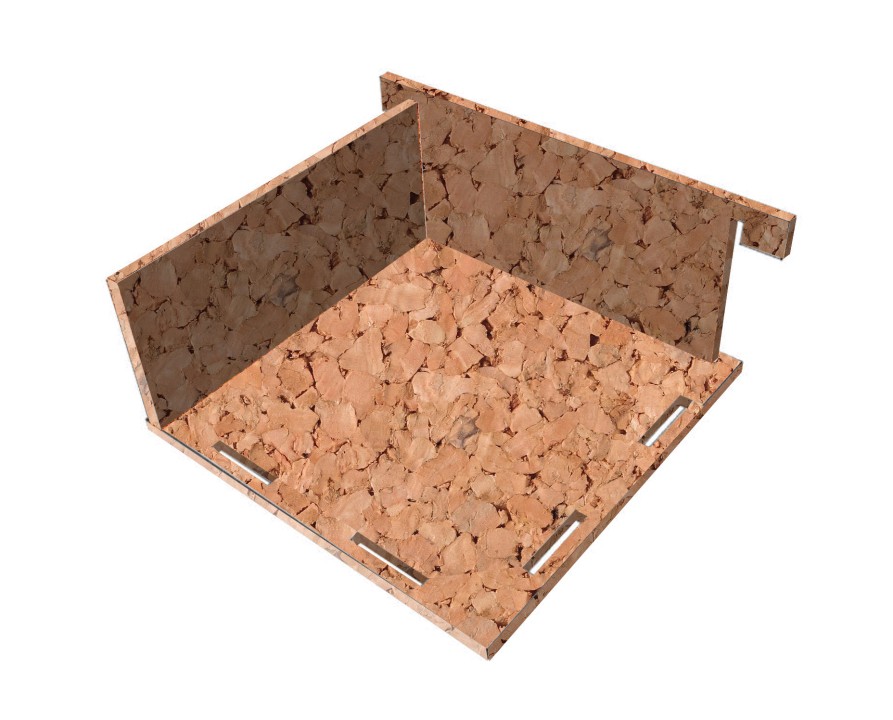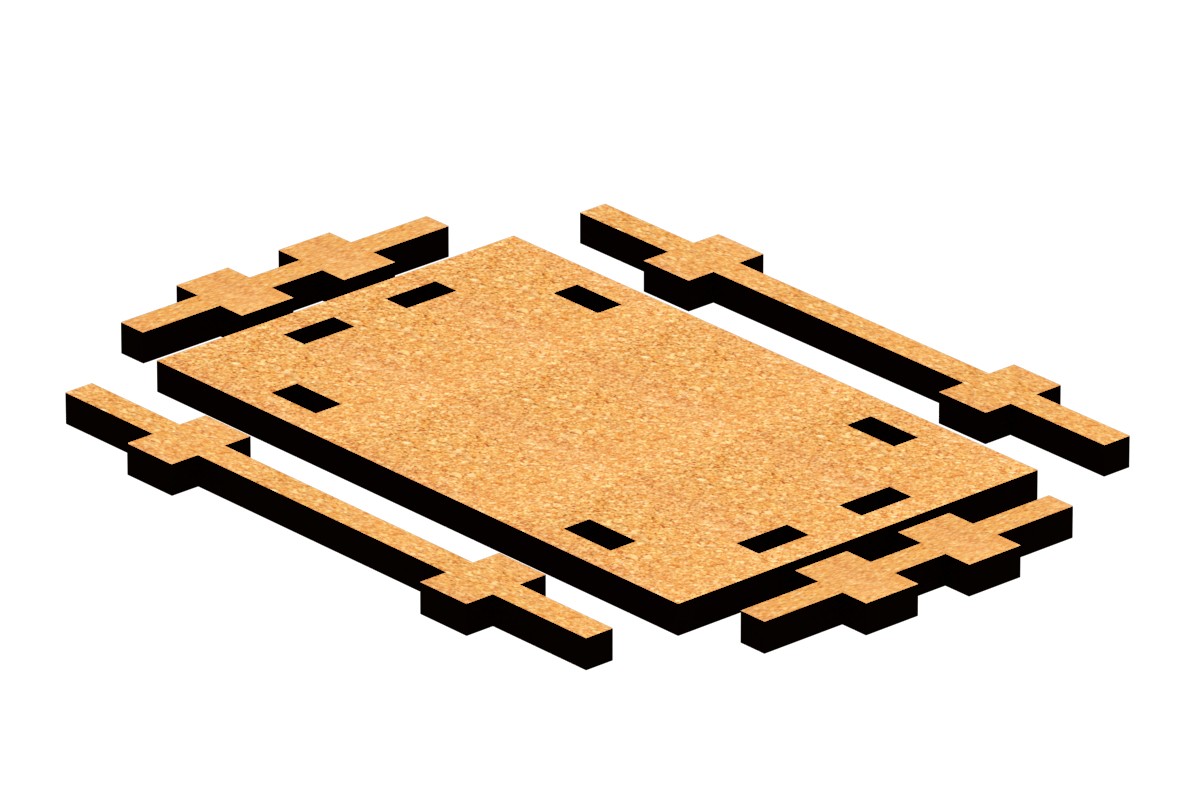Looking to the past to think about the future, cork packaging that can be assembled with joints.
For the design, as an alternative to traditional substrates, cork was used, which among the materials in nature, has the most important insulating characteristics, used since ancient times in many sectors, including precisely the preservation of food. These are the chemical and physical characteristics that make cork a suitable candidate to partially replace both expanded polystyrene and corrugated cardboard. Impermeability to liquids and gases: this characteristic of cork is caused by the increased presence of suberin. Its quantityis around 39 - 45% of the cork mass.

Substance increases the water-repellent properties of the structure and also strengthens it and acts as a heat insulator. Thermal insulating properties: the heatconduction coeffcient of this material is 0.037-0.040 W/(mK). In addition to this characteristic, it should be noted the great value of its own heat. This value translates into the high thermal inertia of cork. Unlike other materials, cork maintains insulating properties over a wide range of temperatures. From this point of view it far surpasses polystyrene, which evaporates at high temperatures.

But that’s not all, because the cork oak is an ally against desertifcation. The cork oak, in fact, due to its very high ability to live in soils in arid climates such as those bordering the western basin of the Mediterranean, constitutes an important barrier to desertifcation which now also threatens large areas of southern Europe. In fact, not only it resists to long periods of drought, but with its foliage it prevents rapid dehydration of the underlying soil, thus also defending many other plant species that live in the woods with it, in perfect symbiosis.
But that’s not all, because the cork oak is an ally against desertifcation. The cork oak, in fact, due to its very high ability to live in soils in arid climates such as those bordering the western basin of the Mediterranean, constitutes an important barrier to desertifcation which now also threatens large areas of southern Europe. In fact, not only it resists to long periods of drought, but with its foliage it prevents rapid dehydration of the underlying soil, thus also defending many other plant species that live in the woods with it, in perfect symbiosis.

Prototyping Laboratory of a Container Intended for Over-the-Counter Foods
We work with the combined passion of creating design solutions to make people’s lives richer, and the commercial understanding to make them incredibly successful.
We work on a diverse range of projects, and it is this diversity that not only keeps our team fresh, excited and engaged but also informs and enhances creativity through the transfer of knowledge and skills between disciplines. Whether we are designing a single product, complete ranges, experiences, brands, environments or strategies, our blend of research, insight and design creates thoughtful solutions that succeed in their markets.

Barber and Osgerby approach is characterized by its emphasis on experimentation and innovation and an exploratory attitude to materiality and color. From these areas of focus emerge solutions that reflect the close relationship of their work with industrial processes and new technologies. The flatbed cutting plotter is designed for a limited production, therefore not serial. So, if the machinery were not duly modifed, the wear and tear of some mechanical parts would increase exponentially, with a relative increase in maintenance costs.
The Three-Dimensional Design to Better Understand the Possibilities and Potential of the Tray.
Let’s start from the assumption that cork has different mechanical characteristics compared to corrugated cardboard, for example. The project should be thought of as a set of elements that can be assembled, where the joints are the alter ego of the fold. The frst phase of the drawing involves the dimensioning of a hypothetical food/encumbrance, let’s take for example a dairy product, with a regular shape, previously packed in food grade poly-coated paper. Having acquired the volume of the product, the sketch on paper begins. An attentive designer will have to foresee multiple aspects which, if eluded from the beginning, may require subsequent corrections.
One of many precautions is the arrangement of the individual flaps, naturally the yield, because the imposition layout depends on the format of the cork sheet and the correct design of the packaging components. The CAD plan composed of poly-lines will allow the plotter, through a series of buffer settings, to carry out shaping and cutting of the parts which will later be assembled by observing the foreseen joints. This interlocking method could be either plug-in, like the container we refer to in this article, or, if the thickness of the cork sheet allows it, rail-based. The linear plotter has a perpendicular perimeter cut, but for similar processes perhaps a longitudinal cut could be thought of.

The most suitable printing system for a cork packaging, which in any case is already aesthetically pleasing and pleasant to the touch in its natural state, is certainly screen printing, which is well suited to both more artisanal productions and industrial types of printing. Completed the design and analysis process, thanks to the kind availability of the company Just Laser Srl (a family business specializing in laser machines for engraving, cutting and marking of a large variety of materials such as metals, wood, acrylic, plastic , fabrics and many others based in Rocco Briantino -MB). With the support of Alessandro Rossi, sales director of Just Laser, it was possible to ascertain in practice the correct workmanship and functionality of the self-assembled tray with cork joints. The sampling produced through laser cut ting made it possible to evaluate the exact precision of the shaping and therefore also the possibility of composing any type of joint, dispelling any doubts about the fact that the laser beam would have partially burned the wooden material. On the contrary, the wall of the cut was perfectly smooth, with no defbrations that would certainly have been produced by the cut made with a traditional blade paper converting plotter.
